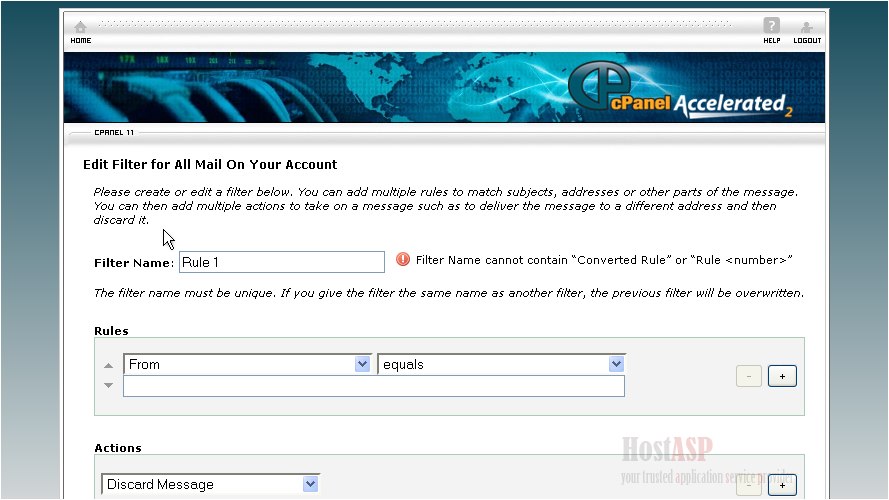

- #Cpanel filter directory from awstats update
- #Cpanel filter directory from awstats verification
- #Cpanel filter directory from awstats software
- #Cpanel filter directory from awstats code
- #Cpanel filter directory from awstats password
An attacker can gain Admin Panel access using malicious SQL injection queries to perform remote arbitrary code execution.ĬPanel before 90.0.17 allows self-XSS via the WHM Transfer Tool interface (SEC-577).
#Cpanel filter directory from awstats password
The WHM Locale Upload feature in cPanel before 98.0.1 allows XXE attacks (SEC-585).ĬPanel before 94.0.3 allows self-XSS via EasyApache 4 Save Profile (SEC-581).ĬPanel before 92.0.9 allows a MySQL user (who has an old-style password hash) to bypass suspension (SEC-579).ĬPanel before 92.0.9 allows a Reseller to bypass the suspension lock (SEC-578).ĮGavilan Media Under Construction page with cPanel 1.0 contains a SQL injection vulnerability. The WHM Locale Upload feature in cPanel before 98.0.1 allows unserialization attacks (SEC-585). In cPanel before 98.0.1, /scripts/cpan_config performs unsafe operations on files (SEC-589). In cPanel before 96.0.13, scripts/fix-cpanel-perl mishandles the creation of temporary files (SEC-586).
#Cpanel filter directory from awstats verification
In cPanel before 96.0.13, fix_cpanel_perl lacks verification of the integrity of downloads (SEC-587). In cPanel before 96.0.13, scripts/fix-cpanel-perl does not properly restrict the overwriting of files (SEC-588). Click OK when your backup is complete.In cPanel before 96.0.8, weak permissions on web stats can lead to information disclosure (SEC-584). Click the last icon (next to the disk icon).Ĥ. Click R1Soft Restore Backups from your cPanel.Ģ.
#Cpanel filter directory from awstats software
MU Sites does automatic server backups using a software called R1Soft. Follow on-screen instructions, and then click Restore. Click Continue to Restore to original location or Restore to new location.ĥ. Restore a backup by clicking the associated arrow.Ĥ. The following steps walk you through restoring your backups.ģ. By default, Do not automatically maintain backups is selected. In the Automatic Backup section, select an option.

Select the checkbox next to the CMS application.ģ. The following steps walk you through setting up an automatic backup of your CMS application.ġ.
#Cpanel filter directory from awstats update
If you are using a CMS, such as WordPress or Drupal, then it’s configured to automatically back up any time there’s an update to the application. MU Sites has several automatic backups available to you. A link to your backup is included in the email. You’ll receive a confirmation email once your backup is finished processing. The backup process will create duplicate files, directories, and database tables.ĥ. Select the checkbox next to the CMS application.Ĥ. To access your CMS application, click your blog link from the Web Applications section of your cPanel. The following steps walk you through accessing a backup of your CMS application.ġ. Click Upload when you’re ready to restore the backup.ĥ. Browse your computer for the backup file.Ĥ. For a complete website restoration, click Choose File from the Restore Home Directory Backup section.ģ. The following steps walk you through accessing a complete and partial backup restorations.Ģ. Once downloaded, you can save the file to your computer, a flash drive, or CD. Click an individual item to download a backup of it.ģ. You can back up your Home Directory, MySQL Database, Email Forwarders, and Email Filters by clicking the Backup link from cPanel.Ģ. Once downloaded, you can save it to a your computer, a flash drive, email, or CD to make it more secure.ġ. From the backup pending page, click Go Back. This email provides the location of your backup and a raw log file.ĥ. You’ll receive an email once your backup is complete. A pending page appears while your backup runs. If your website has a lot of content on it, the backup may take a while.Ĥ. You can have the backup emailed to you once it’s complete. Choose Home Directory from the Backup Destination list, and then click Generate Backup. From your cPanel in the Files section, click Backup.ģ. Please note that Maryville University pays for monthly backups of your site.ġ. These backups can be stored in places such as on your personal computer’s hard drive, a flash drive, or a CD. There are several ways to back up your content, and we recommend you keep at least three backups.
To protect your website content, you need to regularly back up your site. If you have any questions, or would like to learn about an application not listed, email Learning Design and Technology. Each application in your cPanel allows you to customize your website, empowering it with email capabilities and aliases, giving you access to unlimited storage through an FTP server, and protecting your domain through backups and advanced protective software.


 0 kommentar(er)
0 kommentar(er)
